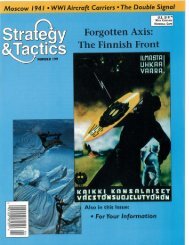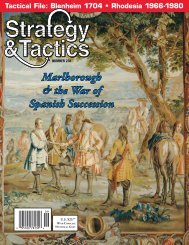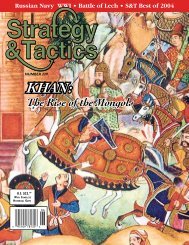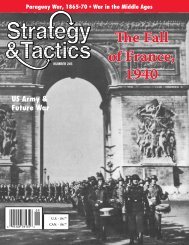COUNTERSTROKE AT SOLTSY - Strategy & Tactics Press
COUNTERSTROKE AT SOLTSY - Strategy & Tactics Press
COUNTERSTROKE AT SOLTSY - Strategy & Tactics Press
You also want an ePaper? Increase the reach of your titles
YUMPU automatically turns print PDFs into web optimized ePapers that Google loves.
58 #232<br />
mega feedback 232<br />
Please take a few minutes to review the following game<br />
proposals and select the ones you would like to see us publish.<br />
Mail in the card found in this issue or e-mail your feedback with<br />
your name and address to Doc at: ccummins@bak.rr.com. This<br />
annual feedback is the most important source for determining<br />
what games we will be working on for future issues of <strong>Strategy</strong><br />
& <strong>Tactics</strong>. In addition, we are seeking your input on other projects<br />
we’re considering.<br />
We also have a feature on our web site (decisiongames.com)<br />
where you can pledge your support for future boxed games. As<br />
the boxed games move up the rankings, they move forward into<br />
design, development, artwork, printing and release. You can<br />
also see the latest listing in the next Dispatch.<br />
The game line-up for the next year will be:<br />
S&T#233: Dagger Thrusts: Monty and Patton<br />
S&T#234: Lest Darkness Fall: Rome<br />
S&T#235: Cold War Battles: Budapest and Angola<br />
S&T#236: They Died With Their Boots On: Custer & Quebec<br />
S&T#237: No Prisoners!: WWI Middle East<br />
S&T#238: Marlborough<br />
S&T Games in development include:<br />
Operation Winged Horse Holy Roman Empire<br />
1066 SEALORDS<br />
Ottomans Twilight Triple Alliance War<br />
Boots 2: Pershing & Mad Anthony Manila ‘45<br />
We need your help in ranking the current candidates for<br />
<strong>Strategy</strong> & <strong>Tactics</strong> to determine our priorities. Remember to<br />
rank each set from first (the one you would like to see published<br />
sooner or have more interest in) to whatever number is in the set<br />
(a set of five proposals for Ancient games would be marked 1,<br />
the most preferred choice, to 5, the least preferred choice).<br />
ancient/medieval/renaissance (to circa aD<br />
1600; mark 1 to 5)<br />
A1. Second Punic War. The epic conflict between the Roman<br />
and Carthaginian republics, 219-202 BC, using the Charlemagne-Xenophon<br />
system. Both the Roman and Carthaginian<br />
players would have to face not only enemy forces in the field<br />
but also shifting alliances, backstabbing stratagems and barbarian<br />
invasions. The game would also include combat results<br />
tables differentiating between the Roman, Carthaginian and<br />
Hellenistic forms of warfare. Joseph Miranda.<br />
A2. Caesar. The civil wars that wracked the Roman Empire<br />
during the late republic, using the classic SPI Battle for Germany<br />
system. Each player would control one faction in the<br />
civil wars (Caesarian, Senatorial, Antonine, etc.) as well as one<br />
“barbarian” faction (Gauls, Parthians, etc.). Players will have to<br />
fight not only their Roman opponents, but also the barbarians<br />
facing them across the frontiers of their particular section of the<br />
Roman world. To win, players must seize control of the city of<br />
Rome and gain public support, the latter measured by a popularity<br />
index. High popularity provides recruits and income; low<br />
popularity means troop desertions. Units will include historic<br />
legions, plus auxiliaries, fleets and barbarian hordes. Joseph<br />
Miranda.<br />
A3. Julian. A strategic/operational-level game of the campaigns<br />
of the 4th century AD Roman Emperor Flavius Claudius<br />
Julianus, who led the later Roman Empire in several campaigns<br />
of military glory, defeating the Germans on the Rhine and<br />
then conducting an invasion of Persia.<br />
A4. Great Medieval Battles. More battles using the system<br />
from the SPI edition. Battles drawn from Crecy (the first<br />
great triumph of the longbow over feudal knights), Hastings<br />
(William the Conqueror versus King Harold), Manzikert (the<br />
turning point of the Byzantine Empire), Leipzig (Mongols<br />
versus Europe), and Arsouf (Richard the Lionhearted versus<br />
Saladin), Battle of the Standard (English versuss Scots), The<br />
Hidden Valley (Mongol Tuman versus The Pagan Empire of<br />
Burma), Maldon (Vikings versus Saxons. The Great Medieval<br />
Battles system uses different sized counters to represent<br />
different troop formations. Rules include fire, melee, cavalry<br />
charges, broken lances, morale, and leaders. Joseph Miranda,<br />
Dick Vohlers, Heath Avery.<br />
A5. Great Renaissance Battles. This will use a system similar<br />
to Great Medieval Battles to simulate two decisive actions<br />
of 1400-1600. The game will use variably sized counters to<br />
show tactical formations: large squares for Spanish tercios<br />
and Swiss phalanxes, rectangles for cavalry, small squares<br />
for skirmishers, etc. Units will be rated for their weapons,<br />
defense and morale, with rules to trace the improvements of<br />
gunpowder weapons in this period. Historic leaders will be<br />
included, and command rules will show the increasing professional<br />
quality of the battlefield. Joseph Miranda.<br />
Gunpowder (circa 1600 to 1900 a.D.;<br />
mark 1 to 6)<br />
B1. Sedan Sequel. We have two possible follow-up games<br />
for Sedan, “On to Paris,” which covers the second half of the<br />
Franco-Prussian War in which the Germans besieged Paris<br />
and the French mounted desperate counteroffensives, and<br />
“1866,” which covers the Austro-Prussian War. If they can<br />
fit on one map and counter sheet we’ll publish both, otherwise<br />
we’ll put the two up for a vote on the next round. Ty<br />
Bomba and Joseph Miranda.<br />
B2. Raj. The Asia Crossroads system recreates the British-<br />
French struggle for control of the Indian sub-continent in the<br />
18th century. Game map will use a square grid, and turns<br />
will each represent four years of operations. Units will be<br />
brigade-level, which can be built up into larger formations.<br />
All major leaders will be shown, as well as naval forces.<br />
Diplomacy will be critical as players must gain the support<br />
of local Indian forces, including the powerful Maharattas.<br />
Players will also be able to develop their economic base by<br />
building trading posts and colonies. There will be several<br />
scenarios, including the Indian part of the Seven Years War.<br />
Joseph Miranda.<br />
B3. War of the Austrian Succession (1741-45). This was<br />
Frederick the Great’s first great campaign, in which he contested<br />
Silesia with Maria Teresa of the Habsburg Empire<br />
in a conflict that involved all the major European powers.<br />
The game will use the S&T Seven Years War/On To Moscow<br />
system to recreate the era of formal warfare. Units will be<br />
infantry and cavalry brigades rated for their strength, morale<br />
and movement. All major leaders will be included. The diplomatic<br />
system will recreate the shifting alliances of the period,<br />
and the balance of power index will let players keep an<br />
eye on whoever is getting too far ahead. Joseph Miranda.<br />
B4. Unknown Napoleonic Wars. This would include two<br />
operational-level games of Napoleonic campaigns rarely<br />
covered. Units will be brigade to division, with leaders and<br />
depots. Campaigns will be drawn from: Beyond the Pyramids







